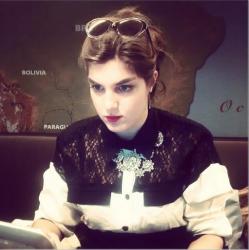With the burgeoning population of Icelandophiles and ever-increasing popularity of tattoos, it should come as no surprise that souvenir tattoos are becoming trendy among tourists to Iceland.
Of course, it’s not a new phenomenon. Fjölnir Bragason of The Icelandic Tattoo Corporation says that up until about ten years ago, every tourist who came to him wanted Björk’s famous tattoo, the runic protection symbol Vegvísir. He tells me people still ask for that one, of course, but not with the same frequency, having broadened their understanding of Icelandic history and culture through the magic of the internet.
All kinds of Viking stuff
Fjölnir says there are three types of tourists coming in to get tattooed by him: walk-ins who show up on a whim, those who come to Iceland specifically to get their tattoo, having made an appointment several months in advance, and Iceland Airwaves festival-goers.
The walk-ins are the most common type of tourist he gets. “They want the runes or magic staves and such, all kinds of Viking stuff,” Fjölnir says. “If they are Americans who have roots in Iceland, they may want something more Viking-esque, like a Viking ship.” Also common are the outlines of Iceland or the silhouette of Mt. Esja.
Then there are the tourists who have made an appointment many months in advance, like the Spanish mercenary soldier who came to Iceland specifically to seek Fjölnir’s services, looking for something more special, “He had to be tattooed by me,” Fjölnir says. “It had to be a Viking protective symbol done by a Viking.”
As for the Airwaves crowd, anything goes. “They’re young hipsters. They want all kinds of things, often music related. But often they go with the tradition of magic runes and stuff.”
“That’s not hów it’s fúcking spelleð”
These trends are common at other tattoo shops around Reykjavík. Jason Thompson of Reykjavík Ink does a lot of tattoos of Ægishjálmur, another magical stave. “The other day, I did it four fucking times. It’s cool, I get it. It’s cooler than a plastic Viking hat or a fucking puffin T-shirt.”
Jason says as far as tourists go, he does a lot of runes, staves, outlines of Iceland, ravens, and phrases in Icelandic, among other things. The phrases in Icelandic can get a little out of hand, as Jason recounts: “We’ve had people come in and say things like, ‘I know this is written in Icelandic, but can you put some of those weird letters in there, to make it more Icelandic?’ And I’m like, well that’s not how it’s fucking spelled.”
Fanciful misspellings aside, many tattoo artists here are generally happy to give tourists tattoos. Marlena Misztalewska of Sweet Hell Tattoo says that she loves it. “They are so fun, so happy. They just want to share their experiences and talk about their countries.”
She understands the urge to memorialize a trip with some permanent ink: “People love Iceland so much they want to get a souvenir that will remind them forever of their time here. They’re doing crazy things on a crazy trip and tattooing is the crazy thing to finish it up with.” Marlena says these tourists follow the typical trend, opting to get runes and mountains and the like.
Keeping up with the Joneses
So while tourism tattoos are trendy, how do tats fit in with Icelandic society? Very well, but of course. Fjölnir, who has been a mainstay of the Icelandic tattoo scene for years, says that the trendy thing now is going big. “It used to be people coming in and getting just a small one, then a medium one, then a big one,” he says. “Now you’ve got people coming in and wanting the whole shebang.” He doesn’t notice any particular style trends, noting, “the trend is mostly in the boldness.”
It’s a good thing Icelanders are more open to a variety of styles, because their seeming obsession with following certain trends almost drove him crazy a few years back. “I sat there for ten years doing nothing but tribal tattoos. Tribals, tribals, tribals.” To avoid stigma, his customers apparently felt “they had to get a tattoo within the frame of what everyone else was doing,” Fjölnir says.
They may be open about getting big, bold tattoos, but it’s not necessarily an indicator of a rebellious streak. “Icelandic people are very, for lack of a better term, ‘keeping up with the Joneses,’” Jason says. “So it’s really good for us, because if you get a really big tattoo, then maybe that chick you work with is like, ‘Shit, that’s cool. I’m going to get one twice as big.'”
Who can blame them?
One thing Jason has noticed since he started tattooing here is the influence that the outside tattoo culture has had on Iceland’s. The owners of his shop have held an annual tattoo convention in Reykjavík since 2006, and Jason thinks that’s had a lot of influence on the widening of taste: “Since those started happening, more guest artists have been coming to Iceland and working, and it’s changed the face of tattooing.”
Marlena has noticed a multicultural influence as well. “Now Icelanders are getting a lot of minimalist and Indian designs like the mandala, and other things connected to Buddhism,” she says. “Before it was more Japanese, like the koi fish, and the Day of the Dead girl from Mexico.” Still, Icelanders being Icelanders, they’re really into their heritage, so she still does a lot of Viking-themed things for them. “A lot of Icelandic people just love Viking things.”
Clearly so do the tourists, but who can blame them?
Buy subscriptions, t-shirts and more from our shop right here!




























